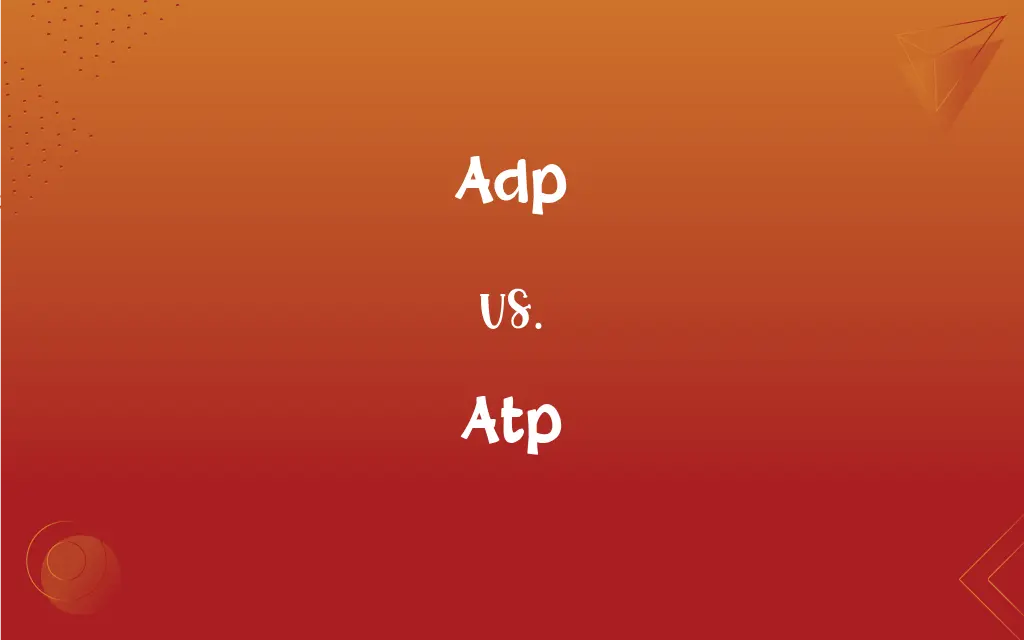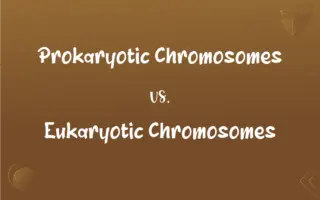ADP vs. ATP: What's the Difference?
Edited by Janet White || By Harlon Moss || Updated on October 21, 2023
ADP (Adenosine Diphosphate) has two phosphate groups, while ATP (Adenosine Triphosphate) has three and is the main energy currency for cells.

Key Differences
ADP, or Adenosine Diphosphate, is a molecule that contains two phosphate groups. On the other hand, ATP, or Adenosine Triphosphate, has three phosphate groups. The presence of these phosphate groups is crucial as they store energy within the molecule. When ATP releases a phosphate group, it transforms into ADP, simultaneously releasing energy that the cell can harness for various functions.
Both ADP and ATP play vital roles in cellular processes, particularly in energy transfer. While ATP is often referred to as the energy currency of the cell due to its ability to store and transfer energy, ADP is essential as it acts as an intermediate during energy exchange. Every time a cell needs energy, one of the phosphate groups from ATP is detached, resulting in ADP and a free phosphate.
The relationship between ADP and ATP is cyclical. Energy from food molecules is used to attach a free phosphate group to ADP, converting it back into ATP. This stored energy in ATP is then readily available for use when required. As cells continuously use and produce energy, ATP and ADP are continually being interconverted in this cycle of energy storage and release.
In summary, while ATP is an energy-storing molecule with three phosphate groups, ADP, with two phosphate groups, is its lower energy counterpart. The interconversion between ADP and ATP is central to the cell's energy management, ensuring that energy is available when needed and stored when in excess.
Comparison Chart
Number of Phosphate Groups
Two
Three
ADVERTISEMENT
Energy State
Lower energy
Higher energy
Role in Cellular Processes
Intermediate in energy exchange
Main energy currency for cellular functions
Conversion
Converted to ATP when acquiring a phosphate group
Converted to ADP when releasing a phosphate group
Structural Composition
Adenine, ribose sugar, and two phosphate groups
Adenine, ribose sugar, and three phosphate groups
ADP and ATP Definitions
Adp
A molecule with two phosphate groups.
When ATP releases energy, it becomes ADP.
ADVERTISEMENT
Atp
Comprises three phosphate groups.
When ATP loses a phosphate, it turns into ADP.
Adp
Represents a state of partially stored energy.
As the cell consumes energy, ATP is gradually converted to ADP.
Atp
The primary energy carrier in cells.
Cells use ATP to power various biological processes.
Adp
Integral for cellular energy management.
The transformation between ATP and ADP is vital for energy balance.
Atp
Adenosine molecule bound to three phosphate groups.
The bonds in ATP store significant energy useful for cellular activities.
Adp
Adenosine with two phosphate groups attached.
The conversion from ATP to ADP releases energy for cellular use.
Atp
Represents a high-energy state in cellular metabolism.
Storing glucose energy as ATP allows cells to have a ready energy source.
Adp
The lower energy counterpart to ATP.
Cells recharge ADP back into ATP to store energy.
Atp
Often referred to as the "energy currency" of cells.
When cells need energy, they often tap into their ATP reserves.
Adp
A nucleotide, C10H15N5O10P2, that is composed of adenosine and two linked phosphate groups, and that is converted to ATP for the storage of energy in living cells.
Atp
A nucleotide, C10H16N5O13P3, that is composed of adenosine and three phosphate groups and releases energy when hydrolyzed to ADP. It is present in all cells, where it is used to store and transport energy needed for biochemical reactions.
Adp
An ester of adenosine that is converted to ATP for energy storage
Atp
A nucleotide derived from adenosine that occurs in muscle tissue; the major source of energy for cellular reactions
Adp
Data processing by a computer
FAQs
And ATP?
ATP stands for Adenosine Triphosphate.
How many phosphate groups does ADP have?
ADP has two phosphate groups.
What does ADP stand for?
ADP stands for Adenosine Diphosphate.
Which molecule is considered the energy currency for cells?
ATP is considered the energy currency for cells.
What happens when ATP loses a phosphate group?
It becomes ADP and releases energy.
How can ADP be converted back to ATP?
ADP can be phosphorylated, adding a phosphate group, to become ATP.
Which molecule, ADP or ATP, has a higher energy state?
ATP has a higher energy state.
Do all cells have the same amount of ATP?
No, the ATP concentration varies depending on the cell type and its energy demands.
Can we directly ingest ATP for energy?
While ATP can be ingested, it's broken down in the digestive tract, so it doesn't directly provide cellular energy when consumed.
How about ATP?
ATP has three phosphate groups.
Why is the conversion between ADP and ATP essential for cells?
This conversion allows cells to store and release energy as needed.
Are ATP and ADP found in all cells?
Yes, they are found in all living cells as part of cellular metabolism.
What role does food play concerning ADP and ATP?
Energy from food is used to convert ADP back into ATP, storing the energy.
Is ATP only used for energy?
While ATP's primary role is energy transfer, it's also involved in other cellular functions.
How does the cell benefit from the cyclical nature of ADP and ATP?
This cycle ensures a balanced energy management system within the cell.
Are there other molecules like ADP and ATP in cells?
Yes, there's also GTP, CTP, and TTP, but ATP is the most prominent in terms of energy.
What would happen to a cell if it ran out of ATP?
The cell would lose its ability to perform vital functions and would eventually die.
Do both ADP and ATP dissolve in water?
Yes, both are soluble in water due to their polar nature.
Can ATP be stored for long periods?
ATP is not stored in large amounts; cells produce it as needed from ADP.
What enzymes help in the interconversion of ADP and ATP?
Kinases and ATPases are key enzymes in this process.
About Author
Written by
Harlon MossHarlon is a seasoned quality moderator and accomplished content writer for Difference Wiki. An alumnus of the prestigious University of California, he earned his degree in Computer Science. Leveraging his academic background, Harlon brings a meticulous and informed perspective to his work, ensuring content accuracy and excellence.
Edited by
Janet WhiteJanet White has been an esteemed writer and blogger for Difference Wiki. Holding a Master's degree in Science and Medical Journalism from the prestigious Boston University, she has consistently demonstrated her expertise and passion for her field. When she's not immersed in her work, Janet relishes her time exercising, delving into a good book, and cherishing moments with friends and family.































































